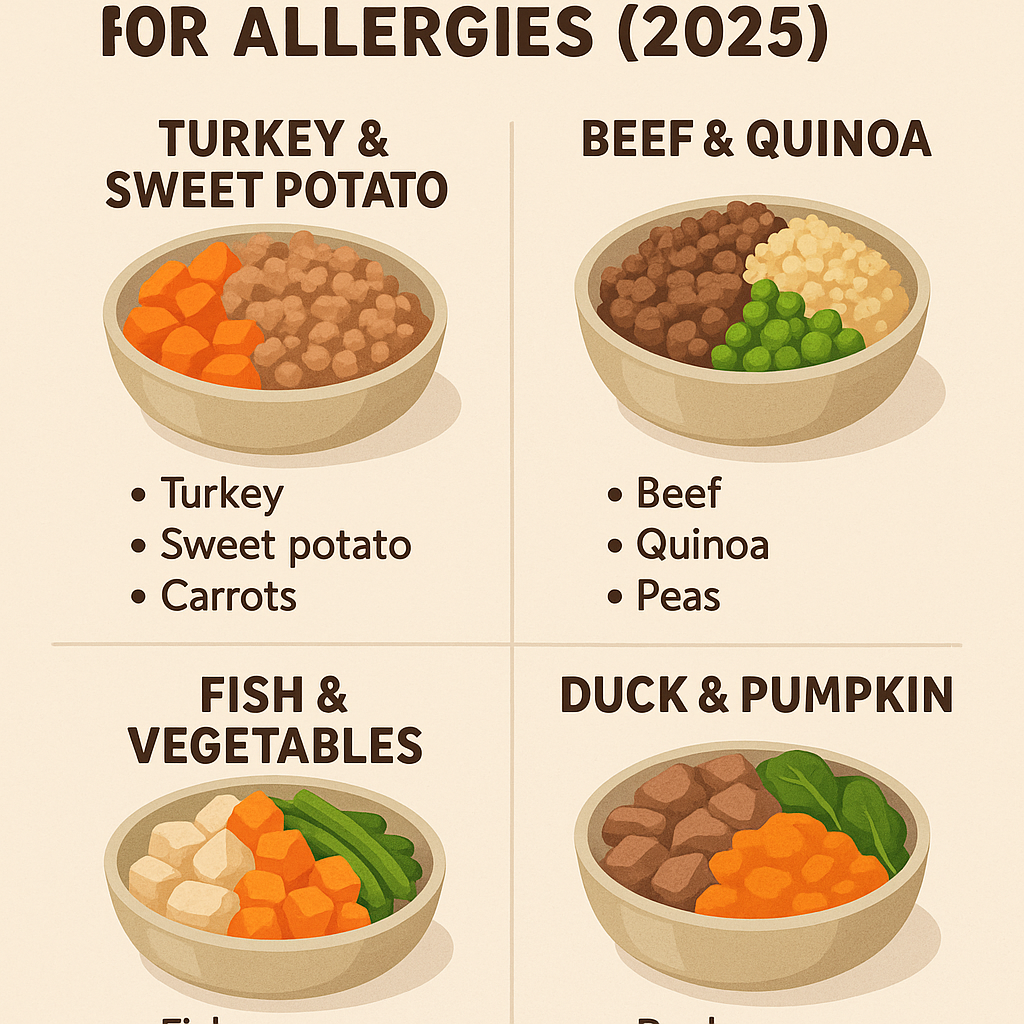
Top Homemade Dog Meals for Allergies (2025)
In recent years, food allergies in dogs have become more common in the USA. Pet owners are increasingly turning to homemade dog food to address sensitivities and allergies that affect their pets’ overall health. This blog post provides the ultimate guide to preparing homemade dog meals specifically designed for dogs with allergies.
We will cover the best recipes, the benefits of homemade food, and tips on how to make sure your dog gets all the necessary nutrients. With the right ingredients and a little bit of effort, you can improve your dog’s health, boost their energy, and make sure they feel comfortable in their own skin.
Why Are Dog Food Allergies on the Rise?
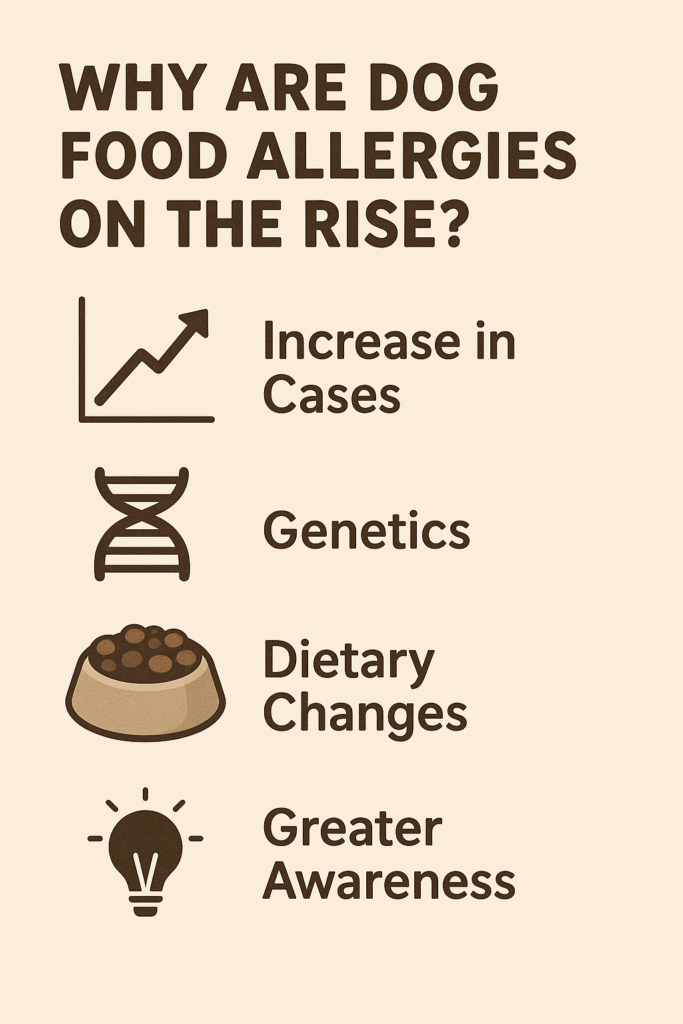
What Are Dog Food Allergies?[Top Homemade Dog Meals for Allergies (2025]
Dog food allergies occur when the immune system of a dog mistakenly identifies certain ingredients in food as harmful. This can cause reactions such as itching, inflammation, digestive issues, and skin problems.
Common Dog Food Allergens:
- Proteins: Chicken, beef, lamb, etc.
- Grains: Wheat, corn, soy.
- Dairy: Many dogs have lactose intolerance.
- Artificial additives: Preservatives and colorants in commercial dog food.
Why Are Food Allergies More Common Now? [Top Homemade Dog Meals for Allergies (2025
The rise in allergies is linked to changes in dog diets, the increase in processed foods, and genetic factors in some dog breeds. Many pet foods on the market today contain fillers and preservatives that might be triggering allergic reactions.
Benefits of Homemade Meals for Dogs with Allergies
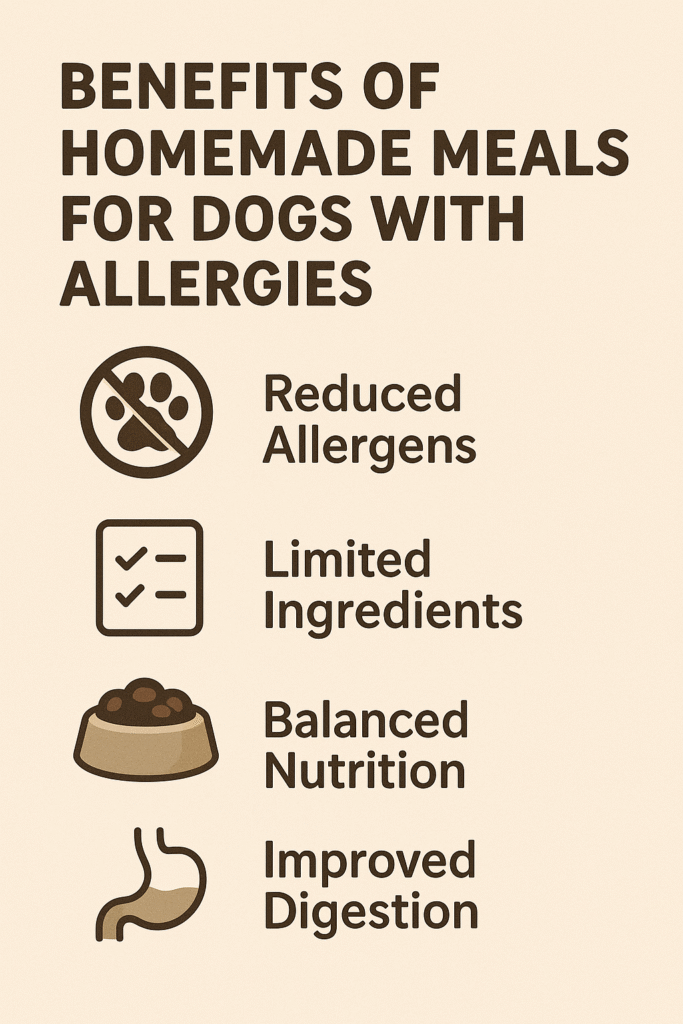
Homemade dog meals offer many benefits for pets with allergies. Here’s why they are a better choice:
- Control Over Ingredients: You can ensure there are no allergens, additives, or fillers.
- Higher Quality Ingredients: Fresh meat, vegetables, and grains that are nutrient-dense and safer for dogs with allergies.
- Improved Health: A well-balanced, homemade diet can lead to better digestion, healthier coats, and more energy.
Top 3 Homemade Dog Meals for Allergies
Each recipe will be explained in detail with a focus on easy-to-follow instructions and nutritious ingredients.
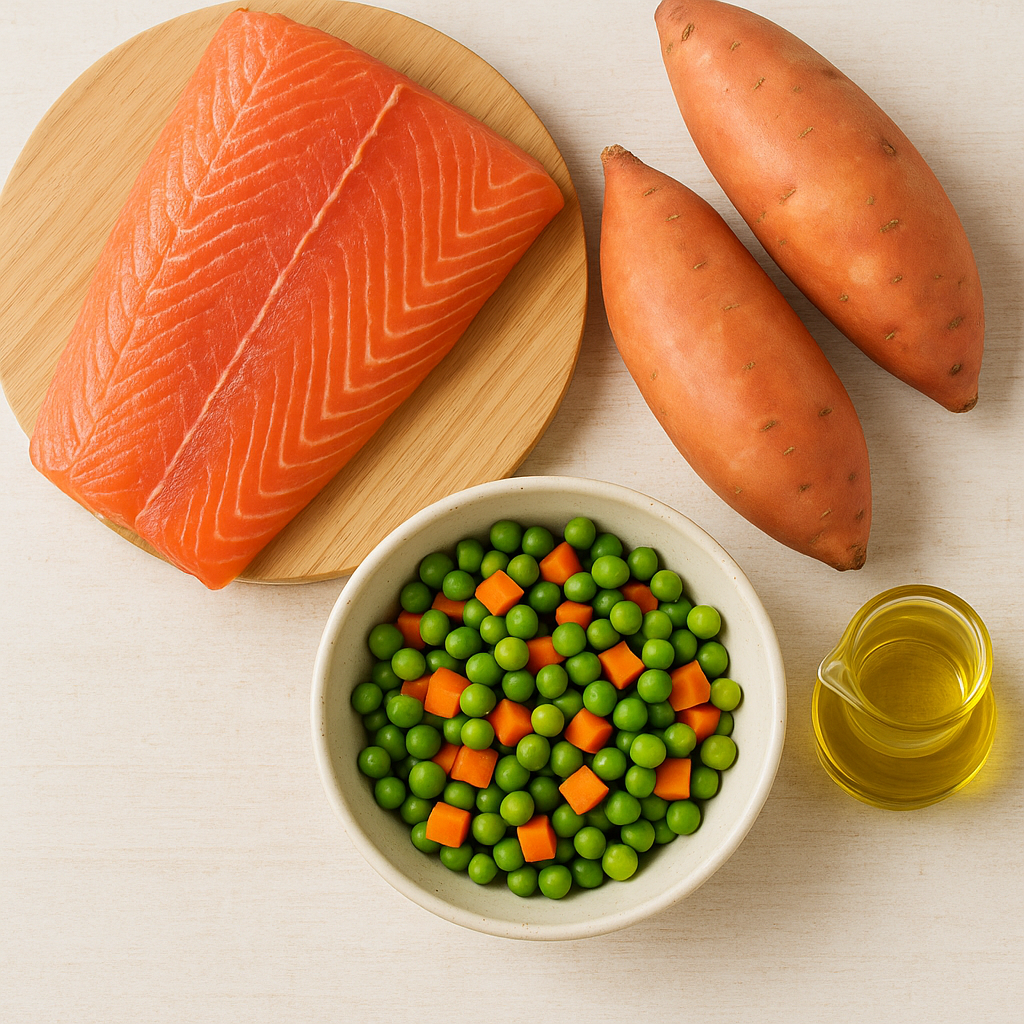
Recipe 1: Salmon & Sweet Potato Bowl [Top Homemade Dog Meals for Allergies (2025)
Ingredients: [Top Homemade Dog Meals for Allergies (2025]
- Fresh salmon
- Sweet potatoes
- Peas and carrots
- Olive oil
Steps:
- Cook the salmon and remove the bones.
- Boil and mash the sweet potatoes.
- Steam peas and carrots.
- Mix all ingredients together in a bowl.
Benefits: This recipe is rich in omega-3 fatty acids and helps with skin conditions caused by allergies. Sweet potatoes are easy on the stomach and promote healthy digestion.
Recipe 2: Turkey & Quinoa Stew[Top Homemade Dog Meals for Allergies (2025)
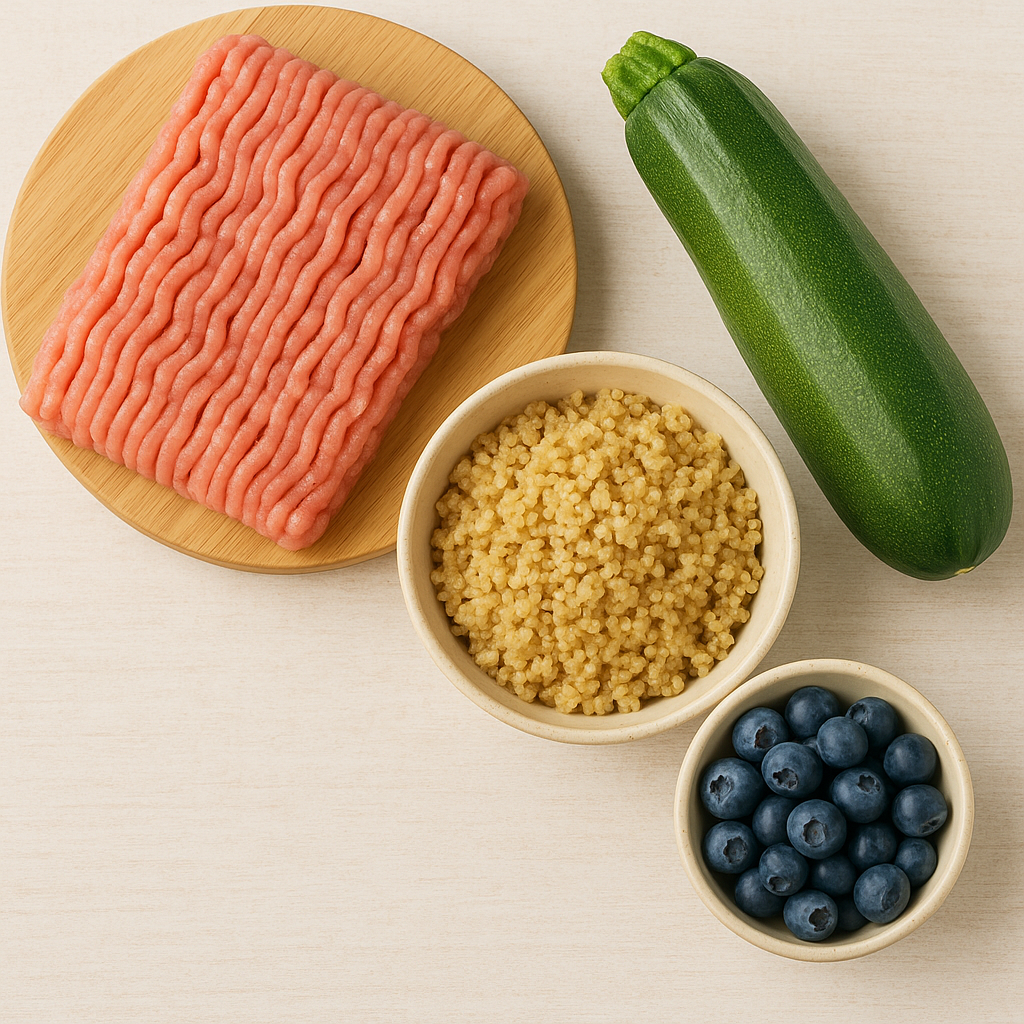
Ingredients:
- Ground turkey
- Quinoa
- Zucchini
- Blueberries
Steps:
- Brown the turkey in a pan.
- Cook quinoa and steam zucchini.
- Combine everything in a large bowl, adding blueberries for an antioxidant boost.
Benefits: Quinoa is a complete protein, providing all nine essential amino acids, while turkey is lean and hypoallergenic, making it perfect for sensitive dogs.
Recipe 3: Duck & Brown Rice Delight
Ingredients:
- Duck breast
- Brown rice
- Spinach
- Carrots
Steps:
- Sauté the duck breast until browned.
- Cook the brown rice and steam the spinach and carrots.
- Mix everything together for a balanced meal.
Benefits: Duck is a novel protein and an excellent alternative to more common meats. Brown rice helps regulate digestion, making this recipe ideal for dogs with sensitive stomachs.
Essential Ingredients for Allergy-Friendly Dog Food
Here are some essential, allergy-friendly ingredients to consider for your dog’s meals:
- Proteins: Duck, turkey, salmon, lamb.
- Carbs: Sweet potatoes, quinoa, oats.
- Fruits and Vegetables: Carrots, spinach, blueberries, peas.
- Fats: Olive oil, coconut oil, flaxseed.
Each of these ingredients plays a critical role in maintaining a balanced diet and ensuring your dog is receiving all the essential nutrients.
How to Transition Your Dog to Homemade Food
Transitioning your dog to homemade food should be done gradually:
- Start Slowly: Mix small portions of homemade food with your dog’s regular food.
- Increase Gradually: Over the course of a week, increase the amount of homemade food.
- Observe and Adjust: Watch for any signs of allergic reactions or discomfort and consult a vet if needed.
How to Store Homemade Dog Food
- Illustrations of food containers: To demonstrate storage tips.
- Colorful storage guide: Use a bright, organized table to show storage times for refrigerated and frozen food.
Content:
To maintain freshness:
- Refrigerate: Store food in airtight containers for up to 3 days.
- Freeze: Portion out food and freeze it for up to 3 months.
- Reheat: Warm up portions to room temperature before serving to your dog.
Can I feed my dog raw food?
Tip:
Always consult your vet before starting a raw diet.
Use only human-grade meat and maintain hygiene.
Include organ meat and balance calcium (bones) properly.
2. How do I know if my dog is getting the right nutrition?
✅ Healthy coat and skin
✅ Normal stool and digestion
✅ Consistent energy levels
✅ Appropriate weight and muscle tone
✅ Clear eyes and good dental health
Bonus Tip:
Use a dog nutrition calculator or consult your vet for a balanced homemade diet plan.
You can also consider adding vet-approved vitamin and mineral supplements.
3. Can I mix store-bought food with homemade meals?
Tips:
Make sure the total meal is nutritionally balanced (don’t overdo treats or high-fat items).
Avoid mixing raw and kibble at the same time (different digestion speeds).
Stick to a routine and monitor for allergies or digestive issues.
4. What should I do if my dog doesn’t like homemade food?
🐾 Try warming it slightly to enhance smell.
🐾 Use a mix of store-bought wet food as a topper.
🐾 Start by mixing small amounts with familiar food.
🐾 Avoid over-spicing or using human food ingredients like onion or garlic (toxic).
Patience is key. Gradually transition and experiment with textures or ingredients your dog prefers.
Conclusion
Homemade dog food is an excellent choice for pets with allergies. By making your own meals, you can ensure that your dog is getting fresh, nutritious ingredients that promote good health. Experiment with different recipes and find the best meals that suit your dog’s tastes and needs. Here’s to happy, allergy-free dogs in 2025


17 thoughts on “Top Homemade Dog Meals for Allergies (2025)”